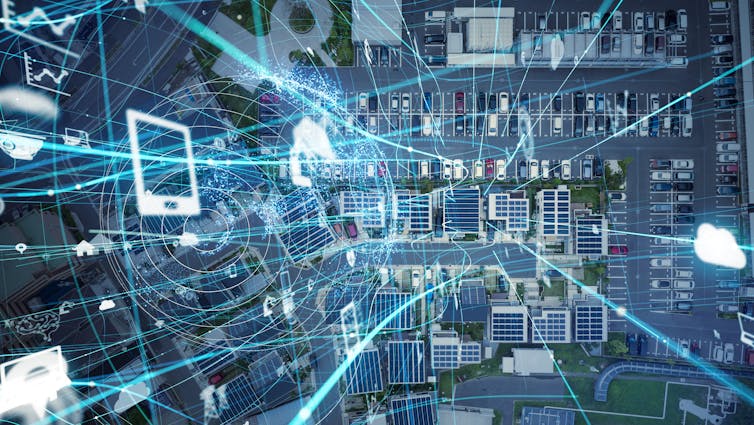Digital technologies will help build resilient communities after the coronavirus pandemic
September 29, 2020
Share

Amid the , a more positive phenomenon is playing out: COVID-19 has provided opportunities to businesses, universities and communities to become hothouses of innovation.
 Around the world, digital technologies are driving high-impact interventions. Community and public health leaders are handling time-sensitive tasks and meeting pressing needs with technologies that are affordable and inclusive, and don’t require much technical knowledge.
Around the world, digital technologies are driving high-impact interventions. Community and public health leaders are handling time-sensitive tasks and meeting pressing needs with technologies that are affordable and inclusive, and don’t require much technical knowledge.
Our research reveals the outsized impact of inexpensive, . In the midst of a maelstrom, these technologies ‚ÄĒ among them social media, mobile apps, analytics and ‚ÄĒ help communities cope with the pandemic and learn crucial lessons.
To gauge how this potential is playing out, our research team looked at how communities incorporate readily available digital technologies in their responses to disasters.
Community potential
As a starting point, we used a model of crisis management developed in 1988 by . The model has five phases:
- signal detection to identify warning signs
- probing and prevention to actively search and reduce risk factors
- damage containment to limit its spread
- recovery to normal operations
- learning to glean actionable insights to apply to the next incident
Although this model was developed for organizations dealing with crises, it is applicable to communities under duress and has been used to .
Our research showed that readily available digital technologies can be deployed effectively during each phase of a crisis.
Phase 1: Signal detection
Being able to identify potential threats from rivers of data is no easy task. Readily available digital technologies such as social media and mobile apps are useful for signal detection. They offer connectivity any time and anywhere, and allow for rapid sharing and transmission of information.
New Zealand, for example, has been exploring an based on both internet-of-things sensors and digital transmission through social media channels such as Twitter.
Phase 2: Prevention and preparation
Readily available digital technologies such as cloud computing and analytics enable remote and decentralized activities to support training and simulations that heighten community preparedness. The federal government, for example, has developed that will tell users whether they have been near someone who has tested positive for COVID-19 during the previous two weeks.
Phase 3: Containment
Although crises cannot always be averted, they can be contained. Big data analytics can isolate hot spots and ‚Äú,‚ÄĚ limiting exposure of larger populations to the virus. Taiwan implemented to quickly react to COVID-19 cases and implement measures to control its spread.
Phase 4: Recovery
Social capital, personal and community networks and shared post-crisis communication are essential factors for the recovery process. Readily available digital technologies can help a community get back on its feet by enabling people to share experiences and resource information.
For example, residents of Fort McMurray, Alta., have experienced the pandemic, and . As part of the response, the provincial government offers northern Alberta residents .
During recovery, it is also important to foster equity to avoid a privileged set of community members receiving preferential services. To address this need, for personal protective equipment and apps that promote can prove useful.
Phase 5: Learning
It is usually difficult for communities to gather knowledge on recovery and renewal from multiple sources. Readily available digital technologies can be used to provide local and remote computing power, enable information retrieval and analysis and disseminate emergent knowledge. The helps youth affected by COVID-19.
A sixth phase
Our research suggests a sixth phase of crisis management: community resilience, which is the sustained ability of communities to withstand, adapt to and recover from adversity. Communities must and other disasters.
When face-to-face interactions are limited ‚ÄĒ like in a pandemic ‚ÄĒ readily available digital technologies can enable community participation through social media groups, virtual meeting software and cloud- and mobile-driven engagement and decision-making platforms.
Technologies that provide transparent information services such as analytics-based dashboards and real-time updates can create a sense of equity and caring. Apps and portals can connect vulnerable populations to critical care, resources and infrastructure services.
For example, the government of Karnataka, India, partnered with local vendors and hyper-local food delivery services for .
Readily available digital technologies help remote communities develop a sense of belonging, sharing and self-efficacy while incrementally building shared knowledge over multiple crises.
Moving forward
The taught us valuable lessons about the use of technology during a pandemic. At the time, readily available digital technologies were largely overlooked, because bigger and more expensive solutions were the focus.
In responding to the present circumstances, it is time we explore the benefit of common technologies. The federal government’s to support the use of digital solutions in community responses to COVID-19 is a promising step.
is also important, since communities depend on public digital infrastructure for access to the internet and other telecommunication networks. This infrastructure must be affordable, sustainable and inclusive.
But we should not lose sight of the need to support communities in developing their own resiliency ‚ÄĒ to help them envision their own solutions using readily available digital technologies.![]()
___________________________________________________________
, Associate Dean (Research & PhD/MSc Programs) and E. Marie Shantz Professor of Information Technology Management, Smith School of Business at ; , Assistant Professor, Business Technology Management, , and , Assistant Professor, Business Technology Management,
This article is republished from under a Creative Commons license. Read the .